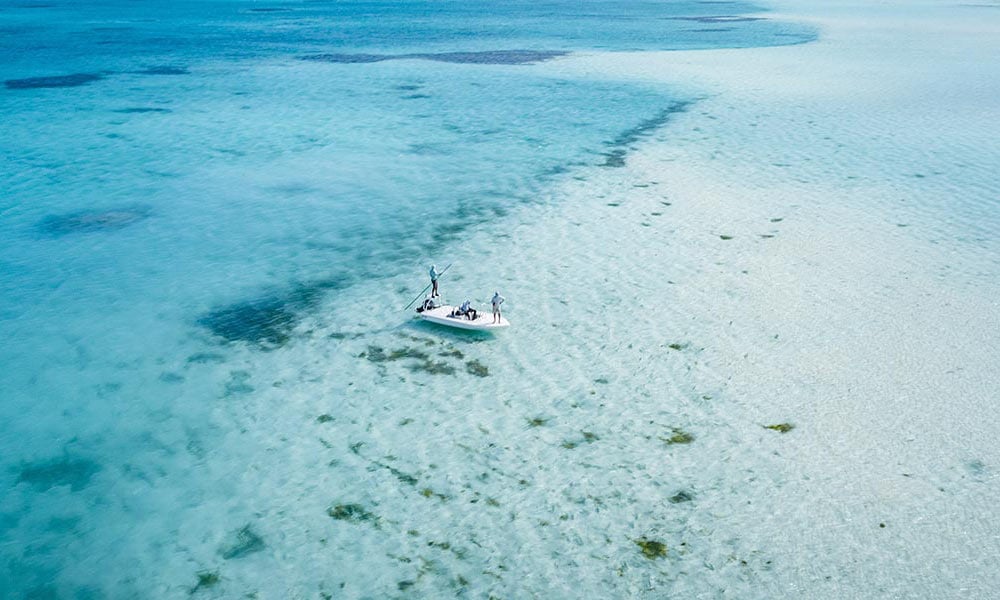Home » Water Types » Flats fishing
Discover top flats fishing destinations worldwide, with experienced local guides and lodges offering direct access to prime waters.

No results available
Whether you’re wading turtle grass, poling coral flats, or working the edge of mangroves, flats fishing is one of the most technical and visual pursuits in the sport. When it all comes together, there’s nothing quite like it.
Flats fishing stands out for its visual, technical nature. You’re not waiting for a bite—you’re spotting fish, tracking their movement, and making a targeted cast. It’s active, focused, and rewarding in a way few other types of fishing can match.
Add in the warm, tropical climates where most flats fisheries are found—clear skies, shallow water, and steady sun—and you’ve got ideal conditions for sight fishing. Whether it’s bonefish tailing on turtle grass or a permit sliding along a mangrove edge, the setting and the challenge are what keep anglers coming back.
Bonefish tail in small groups or cruise solo, often over bright sand or turtle grass. Their speed, caution, and shallow haunts make them the flats staple.
Often found alone or in pairs, permit feed on crabs and shrimp near depressions and edges. They’re notoriously hard to fool—and that’s the draw.
Juveniles hold in warm backcountry bays, while migrating adults push onto oceanside flats. Timing, stealth, and strong gear are all critical.
Found along mangrove fringes and channels, snook strike hard and disappear fast. Their behavior changes with tide and light, making them an unpredictable but exciting flats species.
Often tailing in inches of water, triggerfish require stealth, patience, and accurate flies. They’ll test both gear and nerves.
Giant trevally may charge onto the flats in search of bait, while bluefin trevally track edges and coral heads. These fish hit hard and demand serious tackle.
Often found patrolling tropical flats and reef edges, giant trevally are aggressive, explosive, and demand heavy tackle and fast reflexes. Their strikes are violent, and battles are short but intense.
Expansive white-sand flats and clean sight lines make the Bahamas one of the best places in the world for bonefishing, with the chance at permit or tarpon depending on season.
Mexico’s Yucatán offers productive flats fishing for all three grand slam species—bonefish, permit, and tarpon. The region is guide-rich, accessible, and delivers consistent shallow-water action.
From triggers to GTs and bumphead parrotfish, the Outer Islands offer remote, technical sight fishing across coral flats and lagoon systems.
Other standout destinations for flats fishing include Belize, the Florida Keys, Cuba, Honduras, Mauritius, and French Polynesia. These regions are known for their bonefish, permit, and tarpon fisheries—and remain favorites among serious flats anglers, even if not all are currently featured on FishingExplora.
FishingExplora connects you with lodges and guides who specialize in shallow water sight fishing. From remote atolls to well-known fisheries, our partner lodges deliver the conditions, guides, and timing you need to fish confidently.
Permit are ultra-aware, easily spooked, and require perfect presentations. They often tail on crab beds or cruise edges—and even when the cast is good, they may refuse the fly.
Bottom composition (sand, coral, marl, turtle grass) influences visibility, fly choice, and species behavior. Some fish prefer soft mud or grass, others hunt over bright sand or rubble edges.
Use sidearm casts, adjust your angles, and keep the rod tip low. Wind is almost always a factor—success depends on staying composed and making confident shots despite the gusts.